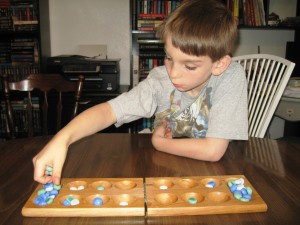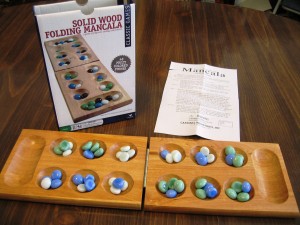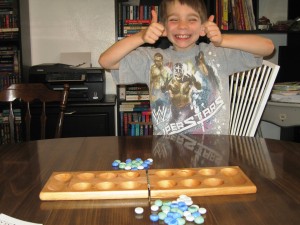I first learned how to play Mancala as a kid; it was part of a games pack that came with some other popular “stone” games on the PC. The game was fairly easy to understand, though I remember the computer being quite the jerk. There was no way to adjust the difficulty, so I’m fairly certain that the personal quest for expanding my vocabulary started there…though Top Gun, Teenage Mutant Ninja Turtles, and Mega Man for the NES were major contributors.
There are many different versions of Mancala, each with their own rule set and variations. I’ll be covering the rule set that came with the Mancala game that I purchased, though I will later list the variations that I know of, in case you’d like to try them.
Components
Board – The board is shaped like a rectangle and is placed between players so that the long sides are facing them. Along the lengths of the board are six small cups and along the widths of the board lie larger scoring cups, or mancalas. The players take ownership of the mancala on their right.
Stones – Stones serve as the playing pieces that players will be moving around the board in an attempt to win the game.
Setup & Gameplay
Four stones are placed in each of the twelve smaller cups. A starting player is chosen, and they take turns picking up all of the stones from one of their six smaller cups and placing one in each subsequent cup going counter-clockwise, including the player’s own mancala and their opponent’s smaller cups. A player does not place a stone into their opponent’s scoring mancala when passing it.
If the last stone you place ends up in your scoring mancala, you get to go again. If your move results in you placing your last stone in an empty space on your side, you can capture ALL of the stones in your opponent’s cup directly across from it. All of those stones, including the stone you captured them with, are placed in your scoring mancala.

You’ll often be counting the spaces your stones will be moving into before actually taking your turn.
Players continue taking turns until one of them has no more stones on their side of the board (in their six cups). The player with the stones left on their side gets to place them into their scoring mancala. Whoever has the most stones in their scoring mancala at that point wins the game.
Variants
Egyptian Mancala – The above rules that I have laid out correspond with the Egyptian rule set of Mancala.
Basic Mancala – The most simplistic version of Mancala in which players don’t follow the capture rule and do not receive an extra turn when they place their last stone in their own scoring mancala.
Ethiopian Mancala – This variant includes all of the rules of the Egyptian rule set but allows players to move either clockwise or counterclockwise on their turn. They also cannot move a stone that is by itself.
I’m sure there are more variants out there, but those are the variants that I am aware of and have played.
The Review
Mancala is very easy to learn but requires players to think ahead on each turn, especially if they play the more complex variants. It encourages critical thinking and has a lot of depth, despite how simplistic the moves are. One bad move can leave you open to capture a few moves down the line. It’s important to plug empty holes on your opponent’s side, lest they land their last stone on it and capture everything on the other side.
In terms of quality, the mancala board that I purchased is made of solid wood. The smoothed stones are colored white, blue, and green. The manual was a one page piece of paper that summed up everything in three short paragraphs. Overall, I am pleased with the components for its price, though the manual could have used a picture or two to illustrate the rules. Luckily, Mancala is so popular that you can find the rules online almost anywhere. The stones did not come with a bag, so one should be careful when unfolding / opening the board for play. Another small gripe I had with board was that the cups were not deep enough, so overflow tended to occur easily in the beginning and middle of the game.
Vinnie Jr enjoyed both the capturing component and thinking about where to go so that he could get an extra turn. We played a total of three games, in which he won two of them. He expressed interest in playing it again soon. The kids enjoyed playing Mancala, playing against me one at a time as I helped to coach them individually. We started with the Egyptian rule set and eventually moved up to the Ethiopian variant, as I felt that the basic rule set would bore them.
Overall, Mancala is a fun little game that you can take with you. I highly recommend it as a game you can play with younger kids, though preferably the ones that have grown out of putting everything in their mouth. If chess is too much for your “younglings”, Mancala would probably make for a good alternative. It’s not as complex as chess, but still encourages critical thinking and is fun to boot.
Final Verdict: 8/10
—



I love mancala. I just taught my 4yr old last year, butI can just as easily play it with my husband. It’s a good standard to have around.